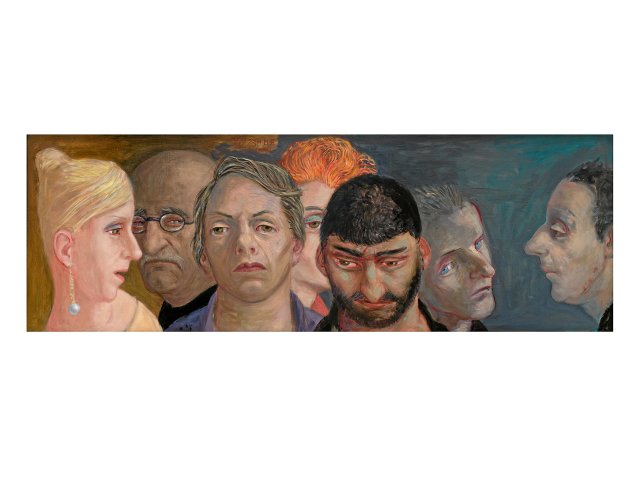Volker Stelzmann, “Köpfefries I”, mixed media on MDF, 2023
Photo: Volker Stelzmann / VG Bild-Kunst, Bonn, 2024, courtesy Galerie Poll, Berlin
One of his most recent pictures is called “Upside Down” (2023/24): people try to hold their ground, they fall, they fall, they want to fight their way back up again – a mass of postures that become a sign of the nature of society. Through the extreme flatness of his color treatment, the painter moves this tangle of bodies to the forefront of the picture, literally forcing it on the viewer. A nightmare on the painting surface…
The Poll Gallery has represented the Berlin painter Volker Stelzmann for more than three decades – now it is presenting new works by him. His figures are lined up next to each other, above and below each other, they support and attack each other at the same time, they assert their egos and help the other, they stagger, fall, they lie on the ground. The artist repeatedly involves himself, sometimes as a homeless person, sometimes as a merciless participant, sometimes as an observer of the scenery. Due to the ambiguity of the events, due to the fact that reality is played out and can be interchanged in the game, each scene represents different content. But you will always be able to discover John the Baptist’s pointing finger from the crucifixion on the Isenheim Altar. Do the figures, whether in ordinary street clothes, identified as hooligans, in large evening gowns, wrapped in robes, in carnivalesque disguises, have pilgrim sticks in their hands, or are they batons? Stelzmann likes to couch his statement in a form that means something generally valid in a special way: in biblical, in art-historical images that formulate human fates in an archetypal manner.
The faces of his figures are drawn with merciless realism, as in his “Frieze of Heads” (2023). Stelzmann seems to be scanning the psychology of a whole sequence of people, into which he has also placed himself. He bears witness to an ambiguous human-social community.
Yes, the painter can translate the spiritual into physical expression. He leaves aside all previously accepted agreements and wants to achieve a shock effect through contrasts, creating torturous visions. A scream can mean aggression as well as pain. The power and seduction of the images is counteracted by the ambiguity of the events.
Some of his figures resemble statues, tailor’s dummies or “manichini” (mannequins) and are assembled from mementos – symbols of the fragmentary modern ego consciousness. But it’s shocking how human they function, how intensely their play reveals identifiable behavior. Despite the large format of the images, Stelzmann manages to compress a lot of psychological threat and violence such as powerlessness and suffering in a claustrophobic manner – and to transform the intensity once achieved into ever-changing metaphors and images.
That is the compelling, traumatic quality of these images: they suddenly stand before us, suddenly, seemingly without ambiguity, as if they were “painted from life”, and they don’t let us go – they become more and more ambiguous and mysterious, more visionary, filled with magical reality. The riddle of an oracle. Then the end of a dream, where fantasy becomes reality again.
»Volker Stelzmann: Dickicht«, until June 8th, Galerie Poll, Berlin
Subscribe to the “nd”

Being left is complicated.
We keep track!
With our digital promotional subscription you can read all issues of »nd« digitally (nd.App or nd.Epaper) for little money at home or on the go.
Subscribe now!
sbobet88 judi bola online link sbobet sbobet
